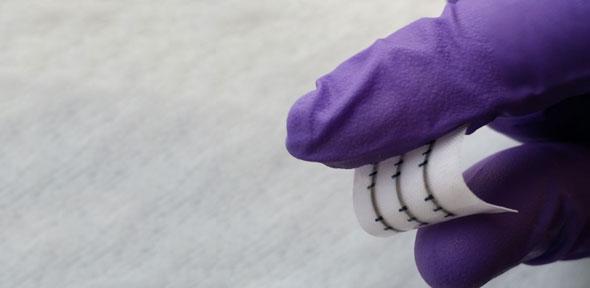Rei Watanabe
You probably won’t find many nanotechnologists at New York Fashion Week, but that may soon change thanks to the work of Felice Torrisi, a researcher at the Cambridge Graphene Center who is pioneering the future of wearable tech.Earlier this year, Torrisi and his colleagues at Cambridge published a paper in Nature Communications that showed how to print fully-integrated washable and stretchable electronic circuits onto fabric.Despite their prevalence in science fiction—from Marty McFly’s auto-fitted jacket in Back to the Future to the neonwave of Tron—wearable electronics have struggled to see wide adoption. Although there were some limited successes like the Apple Watch or Fitbit, these devices were either too cumbersome, ugly, or superfluous.“The so-called wearable devices which we see nowadays have a huge limitation, which is in their rigid electronic parts,” Torrisi told me in an email. “Truly wearable devices will have to fulfill all the requirements of the clothes we wear, such as comfort, breathability, washability, and so on. We wear textiles every day, so integrating electronics using fabric was the most sensible thing to do.” These graphene inks have a low boiling point which means they are able to be washed a little over 20 times before the circuit no longer works. But according to Torrisi, this is just the beginning and it should be possible to build much more robust cloth-printed circuits in the future.“I think that 20 or more wash cycles does not make much difference,” Torrisi said. “The ground-breaking nature of our work is in the fact that we know how to make washable circuits on textiles.”Another benefit of Torrisi’s design is that it is environmentally friendly. Other printed electronics usually require toxic solvents that preclude them from being used on clothing, but Torrisi’s ink is both cheap and safe to use.It’s uncertain where this development will lead in the long term, but Torrisi expects the graphene ink to be used for everything from biosensors for real-time medical diagnostics to consumer fashion. He envisions a future where are clothing naturally incorporates various displays and sensors, but sees no reason why it should be limited to fashion.“I think the future is in electronics that can be worn,” Torrisi said. “But why not also textile displays or curtain televisions?”Humans of the Year is a series about the people building a better future for everyone. Follow along here.
These graphene inks have a low boiling point which means they are able to be washed a little over 20 times before the circuit no longer works. But according to Torrisi, this is just the beginning and it should be possible to build much more robust cloth-printed circuits in the future.“I think that 20 or more wash cycles does not make much difference,” Torrisi said. “The ground-breaking nature of our work is in the fact that we know how to make washable circuits on textiles.”Another benefit of Torrisi’s design is that it is environmentally friendly. Other printed electronics usually require toxic solvents that preclude them from being used on clothing, but Torrisi’s ink is both cheap and safe to use.It’s uncertain where this development will lead in the long term, but Torrisi expects the graphene ink to be used for everything from biosensors for real-time medical diagnostics to consumer fashion. He envisions a future where are clothing naturally incorporates various displays and sensors, but sees no reason why it should be limited to fashion.“I think the future is in electronics that can be worn,” Torrisi said. “But why not also textile displays or curtain televisions?”Humans of the Year is a series about the people building a better future for everyone. Follow along here.
Advertisement
Torrisi said he doesn’t exactly consider himself a fashionista, but he did realize that if wearable tech was ever going to take off, it would only be due to a much more natural melding of regular clothing and electronics.To solve this problem, Torrisi and his colleagues designed a process for printing graphene, a 2-D form of carbon, directly onto fabric to create full electronic circuits. Using this technique, Torrisi and his colleagues printed a reprogrammable memory system and a logic gate—two core components in most everyday electronics— onto polyester. For now, the devices are just proofs of concept and the circuits are too small to be worn. But Torrisi said he and his colleagues are working with clothing designers to demonstrate larger prototypes on clothing items next year.Read More: The Wearable Device That Changes Color Every Time You Change Direction
Advertisement

